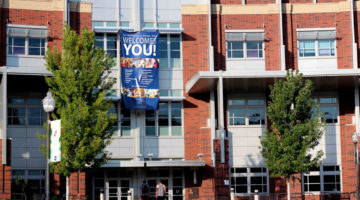
Breanna Denney/Nevada Sagebrush
Sen. Bernie Sanders, I-Vt., speaks before a crowd around 4,500 during a campaign rally at the University of Nevada, Reno, on Tuesday, Aug. 18. Though Sanders began his campaign in anonymity, he has quickly risen to be the only viable challenge to Democratic favorite Hillary Clinton in the 2016 presidential race.
By Jacob Solis
Bernie Sanders is an unusual candidate to say the least. With half a head of wild white hair, the 74-year-old Sanders is older than John McCain was when he ran in 2008 and is often hoarse when he speaks. So how did this independent-turned-Democrat manage to capture the imagination of a generation?
When his campaign began on April 30 of this year, Sanders was flanked by a sizable crowd and more than a few impassioned supporters. Nevertheless, Sanders was a media unknown compared to the Democratic goliath that is Hillary Rodham Clinton. His poll numbers sat in the single digits and a little more than a scant dozen reporters and photographers came out to a news conference following his campaign announcement.
The reporters who were there received a sample of Sanders’s impassioned rhetoric that has since become the senator’s hallmark.
“This country today, in my view, has more serious crises than at any time since the Great Depression of the 1930s,” Sanders said. “For most Americans, their reality is that they’re working longer hours for lower wages. In inflation-adjusted income, they’re earning less money than they used to years ago, despite a huge increase in technology and productivity.”
These sentiments would go on to color every speech Sanders has given thus far on the campaign trail. Even when he visited the University of Nevada, Reno, for a rally in mid-August, Sanders spent much of his time on income inequality, wage stagnation, the need for campaign finance reform and improved trade policy.
“We need a trade policy that tells corporate America that they cannot shut down factory after factory and send jobs overseas,” Sanders said at his Reno rally.
What’s more curious is that Sanders’s has managed to capture the attention of the American youth and the average American Internet-goer. Following the first Democratic primary debate, Facebook polls overwhelmingly chose Sanders as the victor, despite most pundits choosing Clinton.
Last Wednesday, Oct. 28, more than 250 colleges across the country, including UNR, broadcast a Sanders rally at George Mason University at the same time as the third Republican debate, capturing the attention of some thousands of young, eager-to-participate college students. It should be noted, however, that only a dozen students came to see the broadcast at UNR.
Even so, it’ll be an uphill battle for Sanders to rely so heavily on the youth vote.
“For all the talk about young voters, it’s still the case that older voters are going to predominate (in a Democratic primary), even if there’s a large turnout,” said University of New Hampshire associate professor of political science Dante Scala in an interview with USA Today.
A 2014 Census Bureau report on young voters noted that in every presidential election since 1964, young people have turned out in lower rates than every other age group. Even in 2008, when young people turned out in droves for Barack Obama, 18-to-29-year-olds only comprised 17.1 percent of the voting population. For comparison, the same demographic made up 16 percent of the voting population in 2004.
Moreover, Sanders has had trouble wooing women voters and minorities. Though the Black Lives Matter movement has slowly warmed up to the senator since interrupting a campaign rally earlier this year, Sanders was forced on the defensive this week after his campaign manager stirred accusations of sexism.
This all comes despite Sanders’ positive record on civil rights and self-identification as a feminist. It’s become clear to Sanders and observers alike that it doesn’t matter so much what the records are, but how people perceive the records.
In any case, the general election remains a year away, the first primaries only three months. On Oct. 23, Lincoln Chaffee joined fellow Democrat Jim Webb in dropping out of the race for president. Their exits left only Clinton, Sanders and former Baltimore Mayor Martin O’Malley, though with O’Malley’s poll numbers sticking close to the 1 percent mark, the race is quickly shaping up to be a slug-match between Sanders and Clinton.
For now, the campaign goes on.
Jacob Solis can be reached at jsolis@sagebrush.unr.edu and on Twitter @TheSagebrush.











